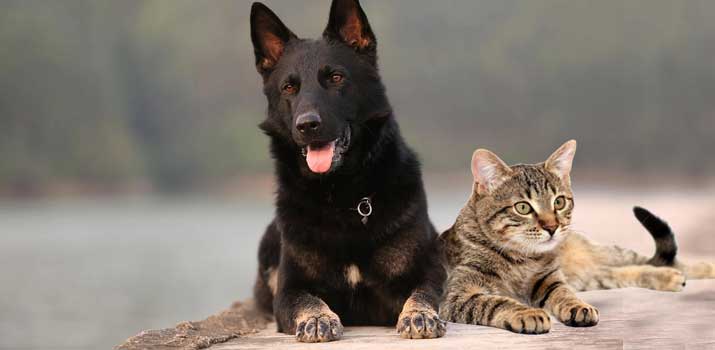
It’s a tale as old as time. The image of an otherwise well-behaved dog chasing a cat across the home is one that’s ingrained in the minds of many. Some parts of that common trope are true. Canines and felines are natural opposites in every sense of the word.
Dogs are loyal and protective. Meanwhile, cats tend to be aloof and thrive on their own.
But does that mean that cats and dogs can never get along? Not necessarily.
All dogs and cats are different. Sure, some dog breeds are more prone to lash out at a cat than others. But dogs are ultimately a product of their environment and training.
So that begs the question: Are German Shepherds good with cats?
All About German Shepherds
If you already have a German Shepherd, you know how loyal and protective these dogs can be. There’s a reason why German Shepherds are the go-to breed for police companions and other jobs.
They’re incredibly smart and have the gusto to take down “enemies” if the situation calls for it.
You see, German Shepherds were originally herding dogs. They were bred and trained to protect livestock. That need to watch over the house and protect it from intruders is ever-present.
This is true even with modern family dogs!
German Shepherds have a naturally high prey drive. This means that they have a penchant for chasing down small animals that have the misfortune of running past them.
You’ve probably witnessed this yourself on your daily walks whenever a squirrel comes into sight.
Can They Cohabitate with Cats?
With all that instinctive prey drive and protective qualities, it doesn’t seem like a good idea to add a cat into the mix.
On paper, it would seem like these two animals could never co-exist in the same home. But, you would be surprised at what’s possible.
Thanks to their high intelligence levels, German Shepherds are smart enough to know when to be gentle and when they need to go on the defensive. It’s what makes this breed so special.
They can fight alongside police in one minute and quickly adapt to family home life the next.
It is possible for German Shepherds to live with cats. Some can grow to downright love their feline family members. However, getting to that point will require some work.
Factors to Consider
Before you even think about adding a cat to your home, there are a few things you need to think about. Even well-trained dogs can have slip-ups or negative experiences with cats.
The last thing you want to deal with is a missing cat and a guilty dog.
The following factors can determine whether or not your German Shepherd is capable of getting along with a cat.
If your dog doesn’t seem to fit the mold, that doesn’t mean that it’s impossible to add a cat to your family. On the same token, your dog could seem like they would do well with a cat but ultimately has issues.
Remember: all dogs are different. These factors are simply a way for you to gauge whether or not the stars are aligned for an introduction.
Ages
Trainers and seasoned dog owners will tell you that younger pups are always open to newer experiences. If your dog is still young, they haven’t developed those biases just yet.
Chances are, most German Shepherd puppies have never seen a cat in their life! So, they’re more apt to accept the cat as one of their own and get along just fine.
The same goes for kittens. Cats are notoriously defensive when they’re older. But as kittens, they’re naturally inquisitive and open to accepting new things. They’re still learning the ropes of how to be a house cat.
Introducing a young kitten to a young dog is the best chance of seeing success. The kitten will be less likely to be frightened. Meanwhile, your pup will learn to get along with the cat.
Cat Personality
Like dogs, cats have personalities that run the gamut of affectionate to aggressive. For the most part, cats tend to be a bit more reserved when introduced to a new environment or situation.
They may spend most of their time hiding and getting a feel for the place before they start viewing your house as a home.
However, cats can be bold, too. Older cats with some past experiences may immediately try to attack your dog.
Gauge the cat’s personality. If they’re naturally calm and timid, you may have a better chance of introducing them to the dog.
Early Socialization
This factor is one of the most important. Has your dog had any prior experience with cats. What about dogs?
If your dog has spent most of its life cooped up in your home, they likely have poor socialization skills. They’re not used to seeing new animals.
Introducing a cat into the mix may cause them to get anxious or aggressive.
Early socialization is very important for young puppies. The more people and animals they are exposed to, the better they will be when new things are thrust upon them.
You can easily check your dog’s socialization skills by taking them to the dog park.
If they thrive around other pups, you have nothing to worry about in the socialization department. But if they seem scared, you need to work on socialization before you introduce them to a cat.
Preparing for an Introduction
The well-being of your pets is the most important thing. Before you bring a cat home, you must prepare both animals for the initial introduction.
This can sometimes take months. But, the time and work will be worth it in the end.
Socializing Your Dog
Whether you have a young pup or an adult dog, it doesn’t hurt to socialize them a bit more.
Bring your dog out some more! Take them on walks through busy streets, visit the dog park, or even go to the pet store!
The earlier you do this the better. German Shepherds best socialized in the first three months of life.
If you’re well past that age, you can still do your part to make them comfortable. Think of it as desensitization training.
Bring them to new environments and provide plenty of praise when they behave well.
The goal is to get them more comfortable with new animals and people. Over time, you’ll notice your dog exhibiting less anxiety and more playfulness. This is what you want!
Training Your Dog
Above everything else, make sure that your dog is properly trained. You might think that your pup listens to you. But in the heat of the moment, you never know what they’ll listen to and what they’ll ignore.
Take your regular training up a notch. You want your dog to learn how to sit down, stay in one spot, and drop anything you tell them to.
Practice standard training routines until your dog will listen to you every time without fail. As always, praise and treats will help make those commands stick.
Never introduce a cat if your dog doesn’t listen to you. Even if they ignore you every once in awhile, they’re not ready. Consider hiring a trainer if you’re still having trouble after repeated training attempts.
Creating a Safe Space for the Cat
Now, onto preparing for your new cat!
It’s important to create an accessible safe space for your cat to run to if trouble occurs. This could be a spare bedroom that your dog isn’t allowed to go into.
Place your new cat’s litterbox, food dish, and toys in this room. Let them get comfortable in their new haven before you attempt to introduce them to your dog.
Scent Familiarization
Here’s an often-overlooked step that can make all the difference. Get two clean cloths that are clean and scent-free. Then collect scent from both your cat and your dog.
You can rub the cloth on your cat’s scent glands, which are located around the face. Or, you can leave it in your cat’s bed for a few days to collect scent naturally.
Use the same technique applies to collect your dog’s scent. However, their scent glands are located on the armpits and sides of the body.
Once those cloths are good and scented, give them to the other animal. Let your cat explore the dog-scented cloth.
Give your German Shepherd the cat-scented one and see how they react. If they go into a fit of rage, you might want to hold off until they get more comfortable!
Repeat this process daily to ensure that the scent is fresh and constant.
The Introduction Process
Introducing your German Shepherd to your new cat is going to take some time. You can’t just toss them in a room and see what happens.
It’s important to take a methodical approach to ensure that both animals are comfortable and collected.
Through Glass
The first step should be to introduce your cat to your dog through some glass. It’s a visual meeting with no scent or contact involved.
Have your dog sit on the opposite side of a glass door or window. Then, bring your cat up. Your animals will have the chance to get close while still having that protective barrier.
Use your training commands to calm your dog if they get a bit aggressive. If they’re calm, provide treats!
Repeat this process several times over a few days.
Through a Gate
Now, you’re going to add scent to the equation. Place your German Shepherd in one room and put up a gate. Make sure the game is not short enough for your dog to hop over.
The grates should be close enough to prevent a daring cat from slipping through, too.
Again, use your training commands and treats. Repeat this process frequently until the two animals are calm enough to move onto the next phase.
With a Leash
Place your German Shepherd on a leash and let your cat roam free. Cats don’t do very well on a leash. Leaving them to free roam also gives your cat a chance to get away.
Slowly bring your dog up to the cat. Make sure you have a good grip on the leash! As you repeat this process, you can let the leash out more and more.
Keep an eye on the body language of your cat and dog. Repeat these meetings as much as necessary. This is the final phase before a true meeting, so you need to make sure that both of your animals are ready.
The True Meeting
When you feel confident with your animals, let them interact untethered. Keep a watchful eye during this first meeting. Hopefully, your pets will sniff each other out and get along.
There may be some curiosity. But as long as it doesn’t turn violent, you’re good to go.
Don’t let your animals spend too much time alone together without your supervision. This new relationship is a learning experience for both of them. You never know when one is going to do something the other doesn’t like.
Conclusion
Introducing a cat and German Shepherd isn’t easy. But, it can be a very rewarding experience. German Shepherds have a reputation for chasing small animals.
However, the right preparation and training and can make the introduction a smooth experience. Before you know it, you’ll find the two animals cuddling and closer than ever!
Also Read: Best Rated Large Breed Puppy Foods

